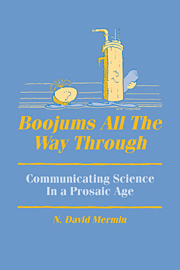Book contents
- Frontmatter
- Contents
- Preface
- I Reflections on the pursuit of physics
- II The quantum theory
- 10 Quantum mysteries for anyone
- 11 Can you help your team tonight by watching on TV?
- 12 Spooky actions at a distance: mysteries of the quantum theory
- 13 A bolt from the blue: the Einstein–Podolsky–Rosen paradox
- 14 The philosophical writings of Niels Bohr
- 15 The great quantum muddle
- 16 What's wrong with this pillow?
- III Relativity
- IV Mathematical musings
12 - Spooky actions at a distance: mysteries of the quantum theory
Published online by Cambridge University Press: 02 December 2009
- Frontmatter
- Contents
- Preface
- I Reflections on the pursuit of physics
- II The quantum theory
- 10 Quantum mysteries for anyone
- 11 Can you help your team tonight by watching on TV?
- 12 Spooky actions at a distance: mysteries of the quantum theory
- 13 A bolt from the blue: the Einstein–Podolsky–Rosen paradox
- 14 The philosophical writings of Niels Bohr
- 15 The great quantum muddle
- 16 What's wrong with this pillow?
- III Relativity
- IV Mathematical musings
Summary
There was a time when the newspapers said that only twelve men understood the theory of relativity. I do not believe there ever was such a time. There might have been a time when only one man did, because he was the only guy who caught on, before he wrote his paper. But after people read the paper a lot of people understood the theory of relativity in some way or other, certainly more than twelve. On the other hand I think I can safely say that nobody understands quantum mechanics.
Richard P. FeynmanIntroduction: the quantum theory
The quantum theory was born in 1900, with the twentieth century, and future centuries will list it among our own's most remarkable achievements. Designed to account for the puzzling behavior of matter at the submicroscopic scale of individual atoms, the theory has enjoyed phenomenal success. It has accounted in a quantitative way for atomic phenomena with a numerical precision never before achieved in any field of science. When it was subsequently applied within the atom to the atomic nucleus – an object some hundred thousand times smaller – no further modification in the theory was needed. More recently, when applied within the particles making up the nucleus to describe their own internal structure – an investigation on a scale as much smaller than atoms as atoms are smaller than us – the quantum theory still shows no signs of requiring extension or revision.
- Type
- Chapter
- Information
- Boojums All the Way throughCommunicating Science in a Prosaic Age, pp. 110 - 176Publisher: Cambridge University PressPrint publication year: 1990



